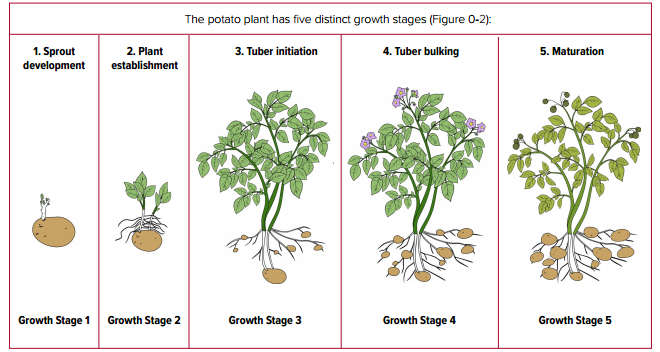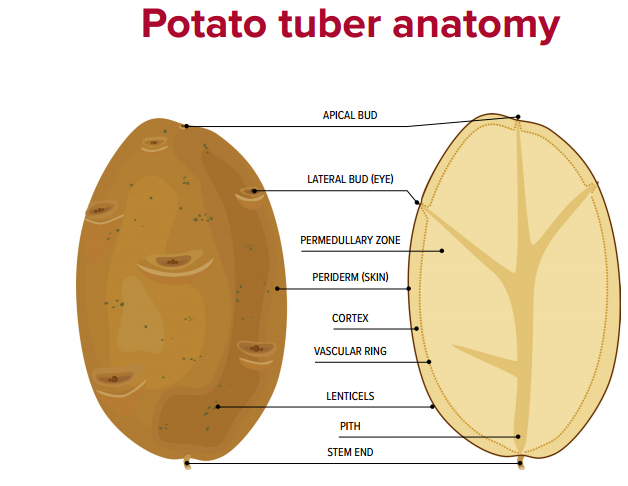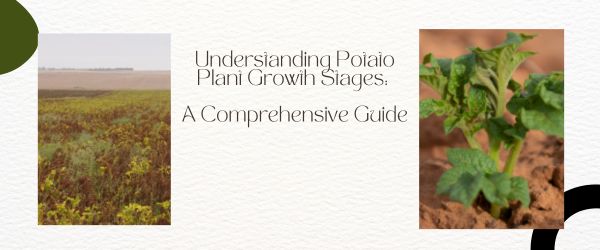#PotatoGrowthStages #PlantEstablishment #TuberInitiation #TuberBulking #Maturation #CropManagement #PotatoFarming #OptimalConditions

Potato plants undergo distinct growth stages that are crucial for their overall development and yield. Understanding these stages and their requirements can help optimize cultivation practices and ensure successful potato production. Let’s delve into each growth stage in detail:

Growth Stage 1 – Sprout Development:
Sprout development marks the initial growth stage after planting, where nutrients and energy from the seed piece provide essential resources for the plant. Factors such as seed dormancy, soil temperature, variety, and seed piece type influence the duration of sprouting. Dormancy, primarily determined by physiological age, can be influenced by cultivar, seed crop conditions, handling, and storage. Sprout elongation is influenced by soil temperature, moisture, and nutrition, with emergence typically occurring two to four weeks after planting.
Growth Stage 2 – Plant Establishment:
During this stage, the potato plant establishes its roots, stolons, leaves, and branches. Optimal soil temperature, moisture, and nutrient conditions are vital as the plant transitions from utilizing energy reserves in the seed piece to absorbing nutrients through root uptake and energy production by the leaves. Nutrient and moisture requirements, along with soil temperature guidelines, play a significant role in achieving successful plant establishment.
Growth Stage 3 – Tuber Initiation:
Once established, the potato plant diverts some of its energy production towards the formation of new tubers. This transition becomes evident as the stolons cease growing, and the tips of the plant swell (hooking), indicating tuber initiation. Moderate daytime temperatures (18 to 20˚C), cool night-time temperatures, soil moisture content above 65%, high light intensity, and moderate to low soil nitrogen levels optimize tuber initiation and growth. Moisture stress during this stage can significantly impact yield potential.
Growth Stage 4 – Tuber Bulking:
Tuber bulking refers to the accumulation of water, nutrients, and carbohydrates within tuber cells. Environmental factors such as temperature, soil moisture, and nutrient availability are crucial for maximizing the rate and duration of tuber growth and dry matter accumulation. Moisture stress during this stage can lead to reduced tuber size, misshapen and cracked tubers, and increased vulnerability to diseases. Proper management is essential to ensure healthy tuber development and quality.

Growth Stage 5 – Maturation:
Maturation is characterized by a decline in photosynthesis, yellowing and loss of leaves, decreased tuber growth rate, and eventual vine death. It is a critical stage preceding harvest, allowing time for skins to thicken and protect the underlying tissue from pathogens. Proper maturation enhances tuber quality, storage life, and resistance to damage. However, over-maturing can negatively affect tuber quality. Understanding nutrient requirements during maturation is crucial for achieving optimal results.
Each growth stage plays a vital role in determining potato plant productivity, tuber quality, and overall crop success. Factors such as soil temperature, moisture, nutrient availability, and disease management significantly impact plant development and yield potential. Proper understanding and management of these growth stages can result in healthier plants, increased yields, and improved crop quality.
